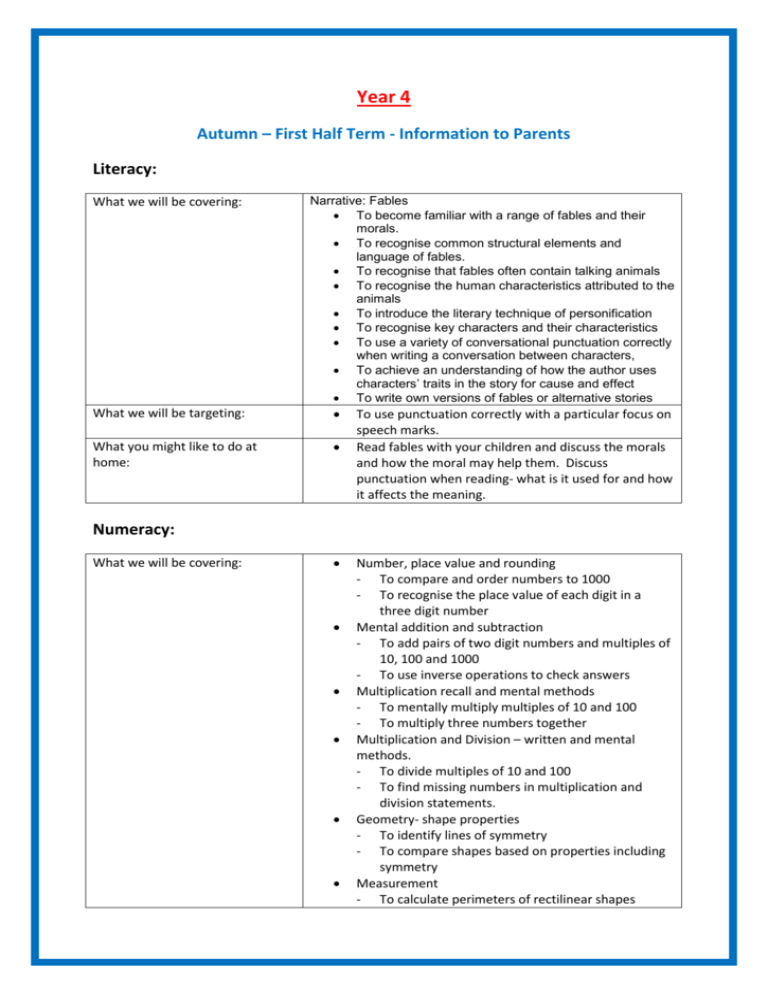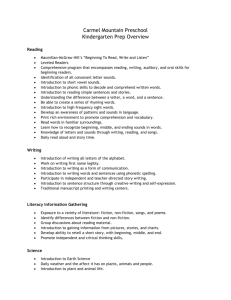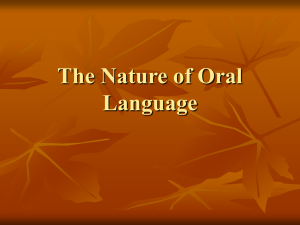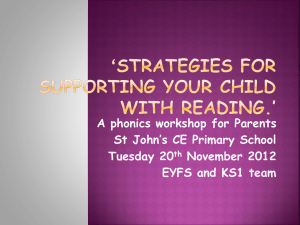Autumn 1 2014 – Year 4 - Radford Semele C Of E Primary School
advertisement

Year 4 Autumn – First Half Term - Information to Parents Literacy: What we will be covering: Narrative: Fables To become familiar with a range of fables and their morals. To recognise common structural elements and language of fables. To recognise that fables often contain talking animals To recognise the human characteristics attributed to the animals To introduce the literary technique of personification To recognise key characters and their characteristics To use a variety of conversational punctuation correctly when writing a conversation between characters, To achieve an understanding of how the author uses characters’ traits in the story for cause and effect To write own versions of fables or alternative stories What we will be targeting: What you might like to do at home: To use punctuation correctly with a particular focus on speech marks. Read fables with your children and discuss the morals and how the moral may help them. Discuss punctuation when reading- what is it used for and how it affects the meaning. Numeracy: What we will be covering: Number, place value and rounding - To compare and order numbers to 1000 - To recognise the place value of each digit in a three digit number Mental addition and subtraction - To add pairs of two digit numbers and multiples of 10, 100 and 1000 - To use inverse operations to check answers Multiplication recall and mental methods - To mentally multiply multiples of 10 and 100 - To multiply three numbers together Multiplication and Division – written and mental methods. - To divide multiples of 10 and 100 - To find missing numbers in multiplication and division statements. Geometry- shape properties - To identify lines of symmetry - To compare shapes based on properties including symmetry Measurement - To calculate perimeters of rectilinear shapes What we will be targeting: What you might like to do at home: including sides with lengths not given. - To convert between units of time, measure, pounds and pence. Written addition and subtraction - To add four digit numbers using column addition, estimating to check - Use a written column method of subtraction and check by adding. To use written methods for addition and to begin to develop them for subtraction. To convert between measures (mm, cm, m, km). Practice the times tables up to 12 x 12. To check your child is confident with his/her 2, 5 and 10 times tables and then move onto the 3,4,6,7,8,9, 11 and 12. To look for patterns in the times tables. To add 10, 100 to numbers and 9, 11 and by adjusting (adding 10 and taking one away or adding one on. Science: What we will be covering: What you might like to do at home: Our Science topic for this half term is Sound. We will be listening carefully to sounds in the environment. The children will learn to describe sounds, to suggest how musical instruments make sounds, why animals prick up their ears and why some have very large ears. The children will learn about how sounds are made and that sounds can travel through gases, solids and liquids. The children will examine the structure of the ear and how vibrations are heard as sounds. They will learn about how people communicate if they are hard of hearing and explore British Sign Language. They will compare light and sound waves and how bats and dolphins use echolocation. The children will investigate soundproofing and discuss why it is important to prevent some sounds from travelling. The children will explore high, low, soft and loud sounds with different instruments. They will investigate changes in pitch and volume and listen to a variety of musical instruments so they can compare their pitch and volume. Talk about different instruments and the different sounds they make. Discuss why their sounds may be different or have a higher or lower pitch. Discuss thunder and lightning and why you hear the sound first… Theme Learning (Art, Design and Technology, History, Geography): What we will be covering: This term our theme is transport. •The physical and human features of different locations for airport travel. •How to design, create and evaluate an airport and a flying machine, using different techniques. •How art has been used to capture images of transport and create own artwork based on this. •About significant individuals special to the local area that have contributed to developments in transportation. •How transport has changed the structure of our country. What you might like to do at home: Talk to your children about different types of transport that you have used. To support your child with their POWer Project which is to design a vehicle (more information to follow). Other Areas of the Curriculum: Weekly Homework Spelling homework- This will be given every Monday and the children’s spelling test will be on a Friday. Literacy/Numeracy Homework- The children will be given one piece of written homework every Wednesday. This will alternate between Literacy and Numeracy. It is to be handed in the following week. Times tables- children are encouraged to learn and practice their times tables and corresponding divisional facts. Reading- Children are encouraged to read daily, ideally to a parent/guardian and a comment left in their reading diary. This can be any book that your child is interested in: comics, information books, e-books, magazines and novels. It would be helpful to discuss the plot, the characters, what is happening between the lines , and how the characters may feel within the stories. Important Dates: School Trip - Visit to Birmingham Airport - Thursday 2nd October









